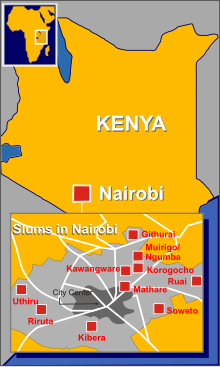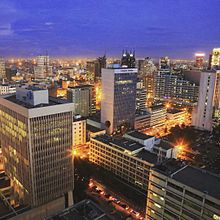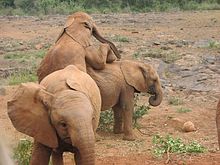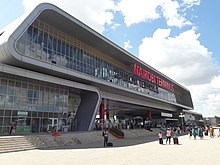Nairobi
| Nairobi | |||
|---|---|---|---|
|
|
|||
| Coordinates | 1 ° 17 ′ S , 36 ° 49 ′ E | ||
| Symbols | |||
|
|||
| Basic data | |||
| Country | Kenya | ||
| Nairobi | |||
| ISO 3166-2 | KE-30 | ||
| height | 1661 m | ||
| area | 703.9 km² | ||
| resident | 4,397,073 (2019) | ||
| density | 6,246.7 Ew. / km² | ||
| Website | www.nairobi.go.ke | ||
| politics | |||
| governor | Mbuvi Gideon Kioko | ||
|
Nairobi skyline
|
|||
Nairobi [ na͜iˈroːbi ] is the capital of Kenya with 4,397,073 inhabitants (August 2019 census), who live on an area of around 704 square kilometers. Until 2010 Nairobi was also the capital of one of the eight provinces of the country, today Nairobi is in Nairobi County .
The name of the city comes from the Maa expression Engare Nyarobie , which means something like "cool river".
geography
Geographical location
Nairobi is located in southern Kenya on the Nairobi River , a tributary of the Athi . Erected at an average height of 1624 m , it is one of the highest capitals in Africa. Nairobi is located just south of the equator at the geographic coordinates of latitude 1 ° 17 ′ south and longitude 36 ° 49 ′ east.
climate
The city is located in the tropical climate zone , but because of its altitude, it has a very pleasant climate for Europeans. The average annual temperature is 19 degrees Celsius, the average annual rainfall is 1024.2 millimeters.
The warmest month is March with an average of 20.5 degrees Celsius, the coldest is July with an average of 16.8 degrees Celsius. Most of the precipitation falls in April with an average of 219.4 millimeters, the least in July with an average of 17.5 millimeters.
| Nairobi | ||||||||||||||||||||||||||||||||||||||||||||||||
|---|---|---|---|---|---|---|---|---|---|---|---|---|---|---|---|---|---|---|---|---|---|---|---|---|---|---|---|---|---|---|---|---|---|---|---|---|---|---|---|---|---|---|---|---|---|---|---|---|
| Climate diagram | ||||||||||||||||||||||||||||||||||||||||||||||||
| ||||||||||||||||||||||||||||||||||||||||||||||||
|
Average monthly temperatures and rainfall for Nairobi
Source: Kenya Meteorological Department; wetterkontor.de
|
|||||||||||||||||||||||||||||||||||||||||||||||||||||||||||||||||||||||||||||||||||||||||||||||||||||||||||||||||||||||||||||||||||||||||||||||||||||||||||||||||||||
City structure
About 60 percent of Nairobi's residents live in slums , of which there are more than 200. To the northeast of the city is the city's oldest slum, located in the Mathare Valley . Along the railway line in the southwest, there is also the slum Kibera , with around 200,000 inhabitants. Earlier estimates that it was the largest slum in Africa, with a population of up to one million, were refuted by a census. Other slums are Korogocho and the agglomerations in Kariobangi .
In the south of Nairobi lies the fashionable suburb of Karen , named after the Danish writer and farmer Karen Blixen , who lived there for many years.
story
Nairobi emerged from a railway warehouse and supply depot that the British administration of Uganda set up in 1896 in the swampy area in central Kenya. A year earlier, the construction of the railway line had started from Mombasa , which was to connect the coast and Uganda with each other. The place in the highlands, populated by Maasai and Kikuyu , was chosen for the railway camp because of the surrounding rivers and the favorable climate. In 1899 the administration of Uganda Railways moved its headquarters to Nairobi, in the same year the administration of the Ukamba Province moved from Machakos to Nairobi. In December 1901 a first city council was formed. At that time the place still had the character of a huge tent camp, one observer described it as "the most lawless and dangerous place in Africa".
Six years later, Nairobi became the capital of the British Protectorate of East Africa (as the later colony of Kenya was called until 1920), replacing Mombasa. It had already grown enormously in this phase. More than 1200 whites now lived here. Nairobi was the commercial and cultural center for the growing number of European settlers in the nearby highlands and the base for the booming hunting tourism. Alibhoy Mulla Jeevanjee , an Indian businessman and building contractor, was responsible for erecting most of the buildings .
The city, which was actually planned for the European and Indian residents of the colony, also attracted many Africans, who made up the great majority of the residents from the beginning. In addition to African and Indian railroad workers who lived in barracks camps, Sudanese and Somali traders and soldiers settled here, porters from all parts of East Africa and the auxiliary soldiers of the colonial troops, especially the Maasai, Nandi and Baganda from the neighboring colony. In addition, numerous Kikuyu moved to the city from the surrounding area. They lived on the outskirts of the city, in illegal neighborhoods, some of which were quickly demolished, others persisted for a while. In 1921 about 12,000 Africans lived in eight different African city quarters, which included Mombasa, Masikini, Kaburini, Kariokor and Kibera, Pumwani and Pangani. The origins of the first organized anti-colonial movement emerged in these African quarters. In particular, the Pangani tea rooms in the eastern suburbs and - on Sundays - the district's sports field were meeting places for politically active people until Pangani was demolished in 1938.
Immigrants poured into the city of Nairobi early on. They often settled on the outskirts of the city, in many places slum-like conditions formed. The city has one of the world's highest crime rates.
In the early 1990s, popular opposition to Kenyan President Daniel arap Moi grew , which resulted in several unrest. University students also demonstrate again and again in the city.
On August 7, 1998, 213 people were killed in a terrorist attack on the US embassy in Nairobi . Today there is a green memorial with a chapel on the site.
In January 2007 the seventh World Social Forum took place in Nairobi , at which the residents of Korogocho had an opportunity to draw the world's attention to their living situation.
On September 21, 2013, Islamist extremists from the Somali Al-Shabaab militia attacked the Westgate shopping center in Westlands, killing at least 68 people.
population
Population development
The following overview shows the number of inhabitants according to the respective territorial status.
|
|
For the year 2050, the agglomeration is expected to have a population of 14.2 million. This would make Nairobi one of the largest metropolitan areas in the world.
languages
The most commonly spoken languages are Kiswahili and English . The youth language Sheng is particularly widespread in the slums .
politics
International
Nairobi is a very international city:
- Nairobi is one of the four cities with a United Nations office (alongside New York, Vienna and Geneva)
- The United Nations Environment Program (UNEP) has its worldwide headquarters in Nairobi.
- The United Nations Program for Human Settlements (UN-HABITAT) has its world headquarters in the Kenyan capital.
- In addition, 22 other regional offices of UN organizations or foundations have their headquarters in Nairobi. B. the FAO or UNHCR . Further information is available from Unic-Nairobi (United Nations Information Center).
- In 1996 the world headquarters of UNEP and UN-HABITAT founded a joint administrative organization, the United Nations Office , Nairobi ( UNON ).
- Other international organizations or media have their headquarters in Nairobi.
Town twinning
-
 Denver , USA
Denver , USA
Culture and sights
Buildings
The National Museum with a comprehensive collection on African prehistory, the Railway Museum , the Parliament Building, the City Hall , the Court of Justice as well as the National Theater and the National Library are of interest . The State House is the official residence of the President.
Nairobi National Park
The Nairobi National Park opened in 1946. The park is only 7 km from the city center, 120 km² in size and is home to a variety of animals: 80 species of mammals and over 500 species of birds have been identified. The park is fenced on three sides, the 4th side is bordered by the river Athi. Most of the park is open plan. In the park you can find a few of the last black rhinos , Maasai giraffes , Cape buffalo , bush pigs ; Thomson and Grant gazelles as well as predators: lions , leopards , cheetahs , panthers and hyenas . The most common species in Nairobi National Park are black-backed jackals , wildebeest , hartebeest, and zebras .
Langatta Giraffe Center
This giraffe center is run by AFEW (African Fund for Endangered Wildlife) in the Langatta district. For children in particular, the main attraction is feeding Rothschild giraffes "eye to eye" from a tower. A 1–2 km long nature trail begins opposite the center in a pristine forest area. Data on the plants and animals along the way can be obtained either from a brochure or from one of the rangers, who also offer guided tours.
Karen Blixen Museum
This is where the Danish writer Karen Blixen lived , who became world famous through the film adaptation of her novel Africa - Darkly Alluring World under the title Out of Africa . Her house was bought by the Kenyan state and has been a museum since 1986, partly furnished with original furniture, but partly with props from the film Out of Africa . Karen Blixen spent 14 years in this house on a former coffee plantation (where the Karen district is now located) until her lover Denys Finch Hatton died. The farm itself went bankrupt, which is why Karen Blixen gave it up and returned to Denmark.
David Sheldrick Wildlife Trust
The Nairobi elephant orphanage is located in the Nairobi National Park and can be reached via Magadi Road, with no entry fee for the national park. Here, under the expert guidance of the biologist Daphne Sheldrick, mainly elephants but also individual rhinoceros babies who have been orphaned through poaching or other circumstances are raised. Since visitors severely impair the work of the carers and biologists, the gates only open to guests between 11:00 and 12:00 or by appointment. Here you can watch elephant orphans playing while keepers and biologists give lectures about animals.
Sports
The Gymkhana Club Ground was one of the venues for the ICC KnockOut 2000 and the Cricket World Cup 2003 .
Economy and Infrastructure
business
Nairobi provides around a fifth of Kenya's total economic output and a large part of industrial production. In 2017, the GDP per capita in County Nairobi (congruent with the city) was 317,700 Kenya shillings (approx. 6,344 international dollars or approx. 2,720 euros ). Nairobi is the economic and communication center of the country Kenya, whereby it stands out due to its high growth rate in the overall African comparison.
Significant industrial products in Nairobi are textiles , clothing, means of transport, building materials and food . Tourism has also increased recently, which means that it is of great economic importance for Nairobi. Nyayo Motor Corporation tried its hand as an automobile manufacturer in the 1980s and '90s. But due to financial difficulties, the project failed.
In a ranking of cities according to their quality of life, Nairobi was ranked 186th out of 231 cities worldwide in 2018.
The city is the headquarters of the Central Bank of Kenya .
traffic
- Road traffic
Almost all traffic in Nairobi is carried out by road; the railroad hardly plays a role. The traffic is regulated by very few traffic lights and only rarely by traffic cops. The lanes are narrow, not marked and often have no sidewalks. In general, the traffic infrastructure is in a very poor condition and there are daily, sometimes massive, traffic jams. A possible solution for this could be the Bus Rapid Transit System, which is currently being planned.
Local passenger transport is handled by buses or matatus . Some of these drive fixed routes and encourage passers-by to take them along by shouting. There are hardly any fixed stops. There are separate buses for cross-country trips, but many matatuses are also used.
- Rail transport
Kenya Railways consistently uses the meter gauge of 1000 mm with different rail weights depending on the route. For passenger traffic (in 3 classes), which has declined significantly in importance, it uses various routes, all of which (with the exception of the connecting railways Voi- Taveta and Kisumu-Butere) start from Nairobi:
- Nairobi - Mombasa
- Nairobi - Kisumu
- Nairobi - Nanyuki
- Nairobi - Kampala ( Uganda ) - only freight traffic.
Diesel locomotives are generally used; a renovated steam train runs every second Saturday of the month as a tourist day excursion from Nairobi to Naivasha (return mostly with diesel-powered vehicles). Another steam locomotive is currently being restored by private individuals and will be available for filming in the future; this locomotive was last used in 1986 when filming Out of Africa .
For a long time, the KR was operated under inefficient management, an inflated workforce and long-loss-making business areas. Therefore there were plans of privatization and revitalization similar to those of Tanzania Railways . In 2005 the Rift Valley Railways Consortium (RVRC) from South Africa won the concession tenders to operate the KR and Uganda Railways . RVRC should start operations on August 1, 2006 and make major investments that would also have involved a reduction in the workforce. On July 28, 2006, the daily East African Standard reported that the acquisition had been postponed to November 1, 2006. The takeover of the operative business finally took place in November and was fixed for 25 years. In 2017, Kenya Railways terminated the contract with RVRC prematurely due to ineffectiveness and lack of payments, so that KRC has been operating again since then.
New line Nairobi – Mombasa:
With the help of funds and technologies from the People's Republic of China through the China Road and Bridge Corporation (CRBC), Kenya built the new standard-gauge railway line Standard Gauge Railway (SGR) between the port city of Mombasa and the capital for the equivalent of around 2.8 billion euros between 2013 and 2017 Nairobi inland. The new line is 472 km long, single-track, and runs largely parallel to the old line and the A109 highway. The maximum speed for passenger trains is 120 km / h, which shortens the travel time between the two cities from twelve hours to four. The maiden voyage of the Madaraka Express on the route took place on June 2, 2017.
The plan is to extend the route further west to Kampala in Uganda . From there there are plans for further routes north to Juba in South Sudan and south via Kigali , Rwanda to Bujumbura in Burundi .
- air traffic
In addition, the Jomo Kenyatta International Airport is located in the southeast of Nairobi , which is the largest and busiest airport in East and Central Africa. On the south-western outskirts of the city is the Nairobi Wilson International Airport , which is mainly used for general aviation .
education
In Nairobi there is the University of Nairobi (UoN), the Kenyatta University , the Jomo Kenyatta University of Agriculture and Technology (JKUAT) (opened in 1956), a polytechnic (opened in 1961), the Catholic University of East Africa and numerous other state and private institutions Universities and several research institutes, which is why it is also known as the “educational capital” of the country.
The UoN is rated by the German Academic Exchange Service ( DAAD ) as one of the best universities in sub-Saharan Africa (except South Africa). Various international research institutions can be found here, such as the renowned International Center for Insect Physiology and Ecology (ICIPE).
sons and daughters of the town
- Lavy Pinto (1929-2020), Indian sprinter
- Roger Whittaker (born 1936), British singer and songwriter
- Richard Dawkins (* 1941), British ethologist and evolutionary biologist
- Richard Leakey (born 1944), paleoanthropologist
- Peter Gerald Hain, Baron Hain (born 1950), British politician
- Anthony Pascal Rebello (* 1950), Roman Catholic religious, Bishop of Francistown in Botswana
- Shafique Keshavjee (* 1955), theologian and university professor
- Kiran Shah (* 1956), film actor and stuntman
- JPR Ochieng'-Odero ( Jimi Patt Roberts ; * 1957), biologist and playwright
- Malik Obama (* 1958), entrepreneur and politician
- Nick Carter (born 1959), British general, military commander in chief of the army
- Wangechi Mutu (* 1972), artist
- Catherine Ndereba (* 1972), marathon runner and Olympian
- Simon Shaw (* 1973), England national rugby union player
- Sharon Laws (1974-2017), British cyclist
- Ingrid Mwangi (* 1975), multimedia artist
- Dodo (* 1977), Swiss reggae and ragga singer
- Mercy Apondi Obiero (* 1978), weightlifter
- Wanuri Kahiu (* 1980), film director
- George Owino (born 1981), football player
- Michael Armitage (* 1984), painter
- Chris Froome (* 1985), British cyclist
- Dennis Oliech (* 1985), football player
- Kévin Oliech (1986-2020), football player
- McDonald Mariga (born 1987), football player
- Kevin Kimani (* 1989), soccer player
- Victor Wanyama (born 1991), football player
- Ayub Masika (* 1992), Kenyan-Belgian soccer player
- Michael Olunga (* 1994), soccer player
- Celeste O'Connor (born 1998), actress
Web links
Individual evidence
- ↑ 2009 Population & Housing Census Results. ( Memento from January 16, 2013 in the Internet Archive ) (PDF; 1.7 MB) KNBS
- ↑ 2019 Kenya Population and Housing Census Volume I: Population by County and Sub-County. In: Kenya National Bureau of Statistics. Retrieved November 17, 2019 .
- ↑ Kenya Meteorological Department: Klimeinformationen Nairobi. World Meteorological Organization, accessed October 27, 2012 .
- ^ The new apartheid slums in Nairobi , Deutsche Welle , February 23, 2007.
- ↑ Muchiri Karanja: Myth shattered: Kibera numbers fail to add up.Daily Nation, September 3, 2010.
- ^ Carl G. Rosberg / John Nottingham: The Myth of Mau Mau. Nationalism in Kenya. Nairobi 1985. p. 23.
- ^ Richard Meinertzhagen : Kenya Diary, London 1983, p. 301.
- ↑ City population 2050 | Sustainability Today. Retrieved July 24, 2018 .
- ^ The David Sheldrick Wildlife Trust .
- ^ Gross County Product 2019 . In: Kenya National Bureau of Statistics . Retrieved March 22, 2019.
- ↑ Mercer's 2018 Quality of Living Rankings. Retrieved August 18, 2018 .
- ^ Deficit operation
- ↑ Privatization plans (PDF file; 130 kB)
- ↑ RVRC wins concession in 2005
- ↑ RVRC's management starts August 1, 2006
- ^ Postponed Takeover , accessed July 31, 2006
- ^ SA Firm gets 'Lunatic Express' railway. ( Memento of the original from June 17, 2007 in the Internet Archive ) Info: The archive link was inserted automatically and has not yet been checked. Please check the original and archive link according to the instructions and then remove this notice. , accessed December 18, 2006
- ^ RVR's 25 years deal to run rail line is terminated. businessdailyafrica.com, April 5, 2014, accessed July 8, 2018
- ↑ https://www.standardmedia.co.ke/article/2001241895/madaraka-express-begins-operations
- ↑ http://edition.cnn.com/2016/05/15/africa/kenya-railway-east-africa/
- ↑ http://www.railway-technology.com/projects/mombasa-nairobi-standard-gauge-railway-project/












